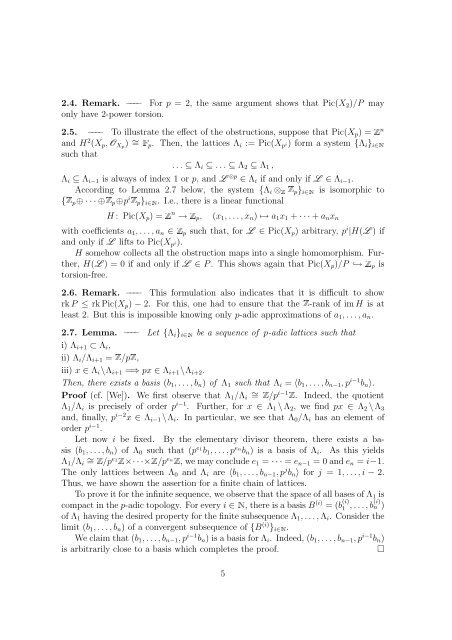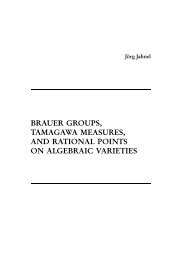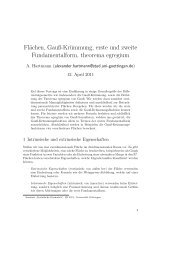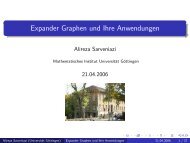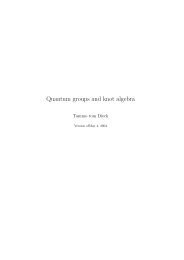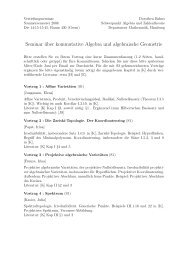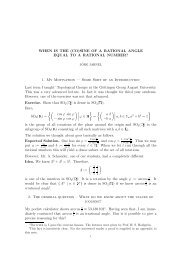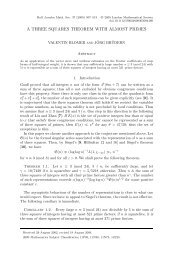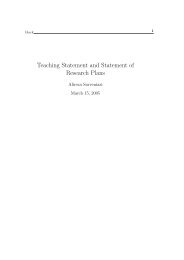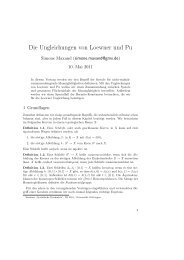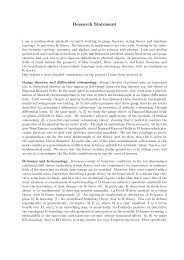The Picard group of a K3 surface and its reduction modulo p
The Picard group of a K3 surface and its reduction modulo p
The Picard group of a K3 surface and its reduction modulo p
Create successful ePaper yourself
Turn your PDF publications into a flip-book with our unique Google optimized e-Paper software.
2.4. Remark. –––– For p = 2, the same argument shows that Pic(X 2 )/P may<br />
only have 2-power torsion.<br />
2.5. –––– To illustrate the effect <strong>of</strong> the obstructions, suppose that Pic(X p ) =n<br />
<strong>and</strong> H 2 (X p , O Xp ) ∼ =p. <strong>The</strong>n, the lattices Λ i := Pic(X p i) form a system {Λ i }<br />
such that<br />
. . . ⊆ Λ i ⊆ . . . ⊆ Λ 2 ⊆ Λ 1 ,<br />
Λ i ⊆ Λ i−1 is always <strong>of</strong> index 1 or p, <strong>and</strong> L<br />
i∈Æ<br />
⊗p ∈ Λ i if <strong>and</strong> only if L ∈ Λ i−1 .<br />
According to Lemma 2.7 below, the system {Λ i ⊗p} i∈Æis isomorphic to<br />
{p⊕ · · · ⊕p⊕p ip} i∈Æ. I.e., there is a linear functional<br />
H : Pic(X p ) =n →p,<br />
(x 1 , . . .,x n ) ↦→ a 1 x 1 + · · · + a n x n<br />
with coefficients a 1 , . . .,a n ∈p such that, for L ∈ Pic(X p ) arbitrary, p i |H(L ) if<br />
<strong>and</strong> only if L lifts to Pic(X p i).<br />
H somehow collects all the obstruction maps into a single homomorphism. Further,<br />
H(L ) = 0 if <strong>and</strong> only if L ∈ P. This shows again that Pic(X p )/P ֒→p is<br />
torsion-free.<br />
2.6. Remark. –––– This formulation also indicates that it is difficult to show<br />
rkP ≤ rk Pic(X p ) − 2. For this, one had to ensure that the-rank <strong>of</strong> im H is at<br />
least 2. But this is impossible knowing only p-adic approximations <strong>of</strong> a 1 , . . .,a n .<br />
2.7. Lemma. –––– Let {Λ i } i∈Æbe a sequence <strong>of</strong> p-adic lattices such that<br />
i) Λ i+1 ⊂ Λ i ,<br />
ii) Λ i /Λ i+1 =/p,<br />
iii) x ∈ Λ i \Λ i+1 =⇒ px ∈ Λ i+1 \Λ i+2 .<br />
<strong>The</strong>n, there exists a basis (b 1 , . . .,b n ) <strong>of</strong> Λ 1 such that Λ i = 〈b 1 , . . .,b n−1 , p i−1 b n 〉.<br />
Pro<strong>of</strong> (cf. [We]). We first observe that Λ 1 /Λ i<br />
∼ =/p i−1. Indeed, the quotient<br />
Λ 1 /Λ i is precisely <strong>of</strong> order p i−1 . Further, for x ∈ Λ 1 \Λ 2 , we find px ∈ Λ 2 \Λ 3<br />
<strong>and</strong>, finally, p i−2 x ∈ Λ i−1 \Λ i . In particular, we see that Λ 0 /Λ i has an element <strong>of</strong><br />
order p i−1 .<br />
Let now i be fixed. By the elementary divisor theorem, there exists a basis<br />
(b 1 , . . .,b n ) <strong>of</strong> Λ 0 such that (p e 1<br />
b 1 , . . ., p en b n ) is a basis <strong>of</strong> Λ i . As this yields<br />
Λ 1 /Λ i<br />
∼ =/p e 1×· · ·×/p en, we may conclude e 1 = · · · = e n−1 = 0 <strong>and</strong> e n = i−1.<br />
<strong>The</strong> only lattices between Λ 0 <strong>and</strong> Λ i are 〈b 1 , . . .,b n−1 , p j b n 〉 for j = 1, . . .,i − 2.<br />
Thus, we have shown the assertion for a finite chain <strong>of</strong> lattices.<br />
To prove it for the infinite sequence, we observe that the space <strong>of</strong> all bases <strong>of</strong> Λ 1 is<br />
compact in the p-adic topology. For every i ∈Æ, there is a basis B (i) = (b (i)<br />
1 , . . ., b (i)<br />
<strong>of</strong> Λ 1 having the desired property for the finite subsequence Λ 1 , . . ., Λ i . Consider the<br />
limit (b 1 , . . .,b n ) <strong>of</strong> a convergent subsequence <strong>of</strong> {B (i) } i∈Æ.<br />
We claim that (b 1 , . . ., b n−1 , p i−1 b n ) is a basis for Λ i . Indeed, (b 1 , . . .,b n−1 , p i−1 b n )<br />
is arbitrarily close to a basis which completes the pro<strong>of</strong>.<br />
□<br />
5<br />
n )


